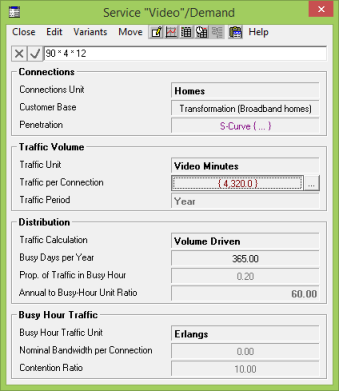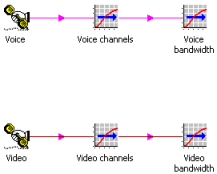The peak-driven, data-service characterisation of the video service belies the fact that a video stream actually requires a good quality of service and sustained connectivity for the duration of the stream (which could be as long as a feature film or longer). It may be preferable to use more of a traditional blocking model for this on the basis of average video minutes.
 Save the model as WiMAX-DSL37
Save the model as WiMAX-DSL37
- Completely revise the traffic assumptions for the Video service (leaving the customer base and penetration alone) as illustrated below:

You can interpret the Traffic assumption as four feature-length films per month.
-
Create two new transformations called Video channels and Video bandwidth by copying the two existing transformations Voice channels and Voice bandwidth. (Make sure you select both of the transformations before copying, so that the link between them is copied too.)

-
Use drag-and-drop, or the connection tool, to set the Video service as the input for the Video channels transformation.
-
Change the multiplier for the Video bandwidth transformation from the 64kbit/s for voice to 5.5Mbit/s. In fact you can link this directly to the existing bandwidth value in the user data for the Video service.
 Save and run the model
Save and run the model
STEM will warn about the Video bandwidth transformation not having any requirements, but you can say OK to this for now. We will resolve this shortly.
- Draw the following charts for the Video service and dependent transformations and make sure that you are happy with the results:
-
Service Demand – Connections, Traffic and Busy Hour Traffic
-
Transformations Output: you should get about 60 video Erlangs and just over 400Mbit/s by the end of the model run.
- The output for the Video backhaul bandwidth transformation is unchanged, but what do you get for WiMAX access bandwidth? Why is this lower than Video bandwidth? How should you fix this?
- Use drag-and-drop, or the connection tool, to set Video bandwidth as the correct input for WiMAX access bandwidth, taking care to re-define the correct input.

- Re-run the model and check the results again. You should see that these results are now comparable to the original formulation.
- But what about the Video server? We will fix this in the next exercise.
- Please save the results workspace before you proceed.
 Things that you should have seen and understood
Things that you should have seen and understood
Service demand, copy and paste, defining inputs with drag-and-drop or the connection tool
Volume Driven